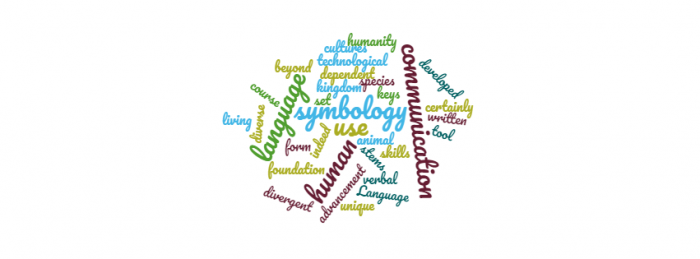Humanity’s Unparalleled Evolutionary Development
February 17, 2020

Human culture stands apart from the culture of other primates whose ancestry we share in the chain of human evolution. It is true, we were once as primitive as our relations, the apes and monkeys were and still are, however somewhere along the path of evolution, we developed uniquely human traits that furthered us a species. It is here that humans diverged from other early hominins and became human. Through the four evolutionary forces of natural selection, mutation, gene flow and genetic drift[1] working in tandem with adaptation of human characteristics over time, Homo sapiens evolved as the most complex and cultured species on the planet as we refined our use of first tools, and then language and agriculture, and subsequently shaped our ability to use technology to our advantage.
While tool use and agriculture certainly contributed to our unique human skills, when humankind developed symbology and language as a form of communication, these inventions set us on a divergent course beyond the capabilities of any other living species in the animal kingdom. All other technological advancement stems from the use of symbology and language, and is indeed dependent on it. Language, symbology, verbal and written communication are the keys to our diverse human cultures, which are the foundation of our humanity.
All culture has been built around these cognitive skills, which we had the biological capability to utilize, long before they were put to use. Even agriculture, which is crucial to our existence, in that it provides the sustenance we need to live, is dependent on communication skills and tools. Anthropological studies show us that human social development did not all happen at once but over a period of time in which biological and cultural evolution worked in tandem creating symbology, language, and the skills needed to share those abilities cognitively with others within the social structure of early humans.[2] We know that in fact, most facets of our cultural development are recent in terms of human development.
An early and important characteristic of hominins, bipedalism, developed some six million years ago, however, the increase of the size of the brain and early tool use in the Homo genus developed nearly four million years later, an estimated two and half, to two million years ago.[3] As larger brains evolved, various aspects of intelligence evolved as well, from complex skills in tool creation and their use, which involved cognitive skills such as using logic to solve problems, to enhanced memory, intuitive and visual spatial skills, and ultimately language. These uniquely human skills and abilities define us now through our culture.
Although much of how we came to be human can be seen through the history of evolution and the four forces of evolution mentioned above, it is theorized that exaptation might also have played a part in the development of cognitive skills, which led first to tool use and then to language. We still do not know exactly what drove us to finally use our brains in the myriad of ways that we do, and we know that there was a huge gap in time between the development of the use of tools and that of language and culture, however, one hypothesis, is the process of exaptation.[4] As we seemingly emerged from tool fashioning to language use, many millennia after the first use of tools, we had first to evolve biologically to have the physical attributes that make up our vocal anatomy, which give us the ability to make sounds and communicate. Fossil research shows that biologically, humans are unique from apes, in that our hyoid bone and our larynx descend in our throats after infancy, creating the necessary anatomical mechanisms for speech.[5]
This human adaptation of the vocal anatomy is far more complex than the difference in our hyoid bone and larynx, and it has been suggested that the evolutionary adaptations necessary for the vocal anatomy in modern humans began as we evolved to bipedalism and upright posture.[6] We did not fully develop the use of these adaptations for many millennia after the adaptations evolved biologically. The vocal capability long existed prior to the first use of language, which noted above, possibly developed through the exaptation of biological adaptations, which were created, through natural selection and the other evolutionary forces at play in our origin.
Without the biological tools that humans adapted through our early evolution, we know that language would not exist, and without language, we would have no culture. For language is the very foundation of human culture. We are the only species to show the ability to mentally process and use symbols and language. Ian Tattersall observes that humans have the ability to break down their surroundings and their lives into words, which they can rearrange in their own minds, and completely, change their perception of things and events through the use of words and symbols.[7] Our cognitive skills give us the ability to live in a world that we have created that is different from anyone else’s world, because they cannot feel what we feel.[8] In this, humans are extraordinary and quite remarkable from other species in the animal kingdom.
Once we achieved the initial cognitive skills needed for communication, those skills, manifested into a wide variety of languages, which became the platform to continue to expand and evolve from, as humans embraced technology as an extension of ourselves, which in truth, one can posit, it is. These remarkable human aspects, Tattersall contends happened in two phases, the first, approximately 200 Ka in Africa, as humans morphed from the primitive body of Homo, and the second 100 Ka ago, also in Africa, as novel symbolic expressions arose from the more highly anatomically developed H. sapiens, that had the existing structure necessary for this type of expression.[9]
Indeed, one can posit that our ability to understand how and when we evolved comes from the evolution of our language skills, which Tattersall contends is our greatest symbolic endeavor.[10] We can look back to other skills acquired long before symbology and language, and see that tool making, building shelters, fire, trade, clothing, all early skills of our Homo ancestors,[11] have all taken on new and more importance with advent of language, as has agriculture, the other prior noted prodigious achievement of humans. Through language and agriculture, humans developed the early social culture that was dependent on these two exceptional and essential biological and cultural adaptations.
Symbology and language emerged approximately 50,000 years ago. There is evidence of earlier symbolic engravings in Africa dating back 77,000 years, however, we see the greatest emergence of cultural expression through language and symbols 40,000 – 50,000 years ago as humans began to expand their territory beyond Africa, into Asia and Europe.[12] Conflicting evidence of when and where culture emerged leads to the view that the emergent culture did not happen in one location at one time, but it happened cumulatively over a period of time, in Africa first. Like symbols and language, agriculture also did not emerge at once in just one location.
In fact, research shows that agriculture developed separately in the Old World and the New World, some 12,000 years ago.[13] While agriculture has certainly changed the way we eat, biologically we remain hunter—gatherers,[14] which gives us pause for thought that were are still evolving, as we have not fully adapted biologically to agriculture. Research shows that language and agriculture brought about a swifter rate of change for humans, as populations grew with the benefit of agriculture and societies grew from small communities to cities and states,[15] whose societies flourished with the advent of language and technology borne of language.
In this, we understand the complexity of human development over the last 200,000 years when modern humans first emerged. Although biological human evolution has been ongoing for some 2.5 million years, the cultural adaptations that arose from the four evolutionary forces at play in our biological evolution appear through research to have been most prevalent in the past 10,000 – 50,000 years.
These more recent developments of language, symbology, and finally, agriculture have had significant impacts on humans culturally and biologically, and they truly substantiate the notion that these biological and cultural adaptations are what make us human. For it is through the biological and cultural adaptations of the past, that humanity arises in all of its biological and cultural glory as a single example of unparalleled evolutionary development; as Ian Tattersall notes, “That we Homo sapiens are the lone hominid in the world today tells us a great deal about quite how unusual we are…”[16]
References
Hill, J. H. (1972, June). On the Evolutionary Foundations of Language. American Anthropologist, 74(3), pp. 308 – 317. Retrieved from http://onlinelibrary.wiley.com.silk.library.umass.edu/doi/10.1525/aa.1972.74.3.02a00030/pdf
Relethford, J. H. (2010). The Human Species. McGraw-Hill.
Tattersall, I. (2008). An Evolutionary Framework for the Acquisition of Symbolic Cognition by Homo sapiens. Comparative Cognition & Behavior Reviews, 3, pp. 99 – 114. Retrieved from http://comparative-cognition-and-behavior-reviews.org/2008/vol3_tattersall/
Tattersall, I. (2009, September 22). Human origins: Out of Africa. PNAS, 6(38). Retrieved from http://www.pnas.org/content/106/38/16018.full
Tattersall, I. (2010). Human evolution and cognition. Theory in Biosciences. Retrieved from http://link.springer.com.silk.library.umass.edu/article/10.1007/s12064-010-0093-9/fulltext.html
Tomasello, M. (1999, October). THE HUMAN ADAPTATION FOR CULTURE. Annual Review of Anthropology, Vol. 28, pp. 509-529 . Retrieved from http://www.annualreviews.org.silk.library.umass.edu/doi/full/10.1146/annurev.anthro.28.1.509
[1] (Relethford, 2010, p. p. 69)
[2] (Tomasello, 1999)
[3] (Relethford, 2010, p. p. 283)
[4] (Tattersall, Human evolution and cognition, 2010)
[5] (Relethford, 2010, p. p. 312)
[6] (Hill, 1972, p. p. 311)
[7] (Tattersall, Human origins: Out of Africa, 2009)
[8] (Tattersall, Human origins: Out of Africa, 2009)
[9] (Tattersall, Human origins: Out of Africa, 2009)
[10] (Tattersall, Human origins: Out of Africa, 2009)
[11] (Tattersall, An Evolutionary Framework for the Acquisition of Symbolic Cognition by Homo sapiens, 2008, p. p. 108 Figure 8)
[12] (Relethford, 2010, pp. p. 339-340)
[13] (Relethford, 2010, p. p. 349)
[14] (Relethford, 2010, p. p. 349)
[15] (Relethford, 2010, p. p. 349)
[16] (Tattersall, An Evolutionary Framework for the Acquisition of Symbolic Cognition by Homo sapiens, 2008, p. p. 112)
* Written for Human Origins and Variation, Sec Anthro 103. December 4, 2014.
Fair Use Disclaimer: Any use of this paper must be cited as Pamela Leavey – Author.
Related Images:






